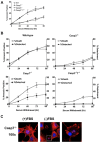Caspase-9, caspase-3 and caspase-7 have distinct roles during intrinsic apoptosis
- PMID: 23834359
- PMCID: PMC3710246
- DOI: 10.1186/1471-2121-14-32
Caspase-9, caspase-3 and caspase-7 have distinct roles during intrinsic apoptosis
Abstract
Background: Apoptosis is a form of programmed cell death that is regulated by the Bcl-2 family and caspase family of proteins. The caspase cascade responsible for executing cell death following cytochrome c release is well described; however the distinct roles of caspases-9, -3 and -7 during this process are not completely defined.
Results: Here we demonstrate several unique functions for each of these caspases during cell death. Specific inhibition of caspase-9 allows for efficient release of cytochrome c, but blocks changes in mitochondrial morphology and ROS production. We show that caspase-9 can cleave Bid into tBid at amino acid 59 and that this cleavage of Bid is required for ROS production following serum withdrawal. We also demonstrate that caspase-3-deficient MEFs are less sensitive to intrinsic cell death stimulation, yet have higher ROS production. In contrast, caspase-7-deficient MEFs are not resistance to intrinsic cell death, but remain attached to the ECM.
Conclusions: Taken together, these data suggest that caspase-9 is required for mitochondrial morphological changes and ROS production by cleaving and activating Bid into tBid. After activation by caspase-9, caspase-3 inhibits ROS production and is required for efficient execution of apoptosis, while effector caspase-7 is required for apoptotic cell detachment.
Figures





References
-
- Galluzzi L, Vitale I, Abrams JM, Alnemri ES, Baehrecke EH, Blagosklonny MV, Dawson TM, Dawson VL, El-Deiry WS, Fulda S. et al.Molecular definitions of cell death subroutines: recommendations of the Nomenclature Committee on Cell Death 2012. Cell Death Differ. 2012;19(1):107–120. doi: 10.1038/cdd.2011.96. - DOI - PMC - PubMed
Publication types
MeSH terms
Substances
Grants and funding
LinkOut - more resources
Full Text Sources
Other Literature Sources
Medical
Molecular Biology Databases
Research Materials

